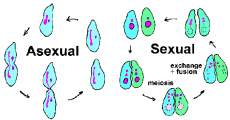

GCSE BIOLOGY REVISION: SEXUAL AND ASEXUAL REPRODUCTION
Please note: Text in bold is what the AQA GCSE biology specification requires an understanding of.
Some organisms reproduce by both methods depending on the circumstances.
Malarial parasites reproduce asexually in the human host, but sexually in the mosquito.
Many fungi reproduce asexually by spores but also reproduce sexually to give variation.
Many plants produce seeds sexually, but also reproduce asexually by runners such as strawberry plants, or bulb division such as daffodils.
A change from sexual to asexual reproduction will only happen if the circumstance requires it.
Sexual reproduction vs. Asexual reproduction
Fungi reproduce sexually to generate variation, fungi release spores by asexual reproduction.
Plants use sexual reproduction to produce seeds, plants such as strawberries reproduce asexually by sending out runners, or daffodils when their bulbs divide.
Malarial parasites reproduce sexually in the host mosquito, malarial parasites reproduce asexually in the human host.
Knowledge of reproduction in organisms is restricted to those mentioned.
So, extra learning will do you no harm but it is not necessary!
Students should be able to describe the structure of DNA and define genome.
The genome is the haploid set of chromosomes in a gamete or microorganism, or in each cell of a multicellular organism- the complete set of genes or genetic material present in a cell or organism.
The genetic material in the nucleus of a cell is composed of a chemical called DNA. DNA is a polymer made up of two strands forming a double helix. The DNA is contained in structures called chromosomes.
A gene is a small section of DNA on a chromosome. Each gene codes for a particular sequence of amino acids, to make a specific protein.
The genome of an organism is the entire genetic material of that organism. The whole human genome has now been studied and this will have great importance for medicine in the future.
Genetic material is found in the nucleus of a cell. It is composed of DNA. DNA is a large complex polymer made of two strands forming a twisted ladder structure. This twisted ladder is called the double helix. DNA carries genetic code, which determines the characteristics of a living organism. Each person’s DNA is unique, with the exception of identical twins. This enables the police to identify people through DNA fingerprinting. DNA can be cut up and separated, which can form a ‘bar code’ that is different from one person to the next.
The nucleus contains chromosomes. DNA is contained within chromosomes and is made up into genes. Genes are a small section of DNA inside chromosomes. Each gene codes for a particular amino acid to make proteins. Genes are described as heredity units as they can be copied and passed onto the next generation.
Image- http://igbiologyy.blogspot.com/2014/04/148-summary-of-reproduction.html

0 Comment:
Be the first one to comment on this article.